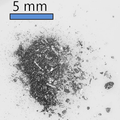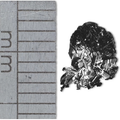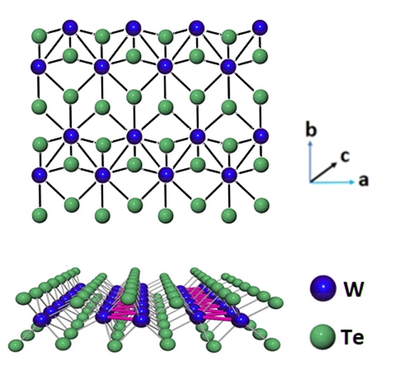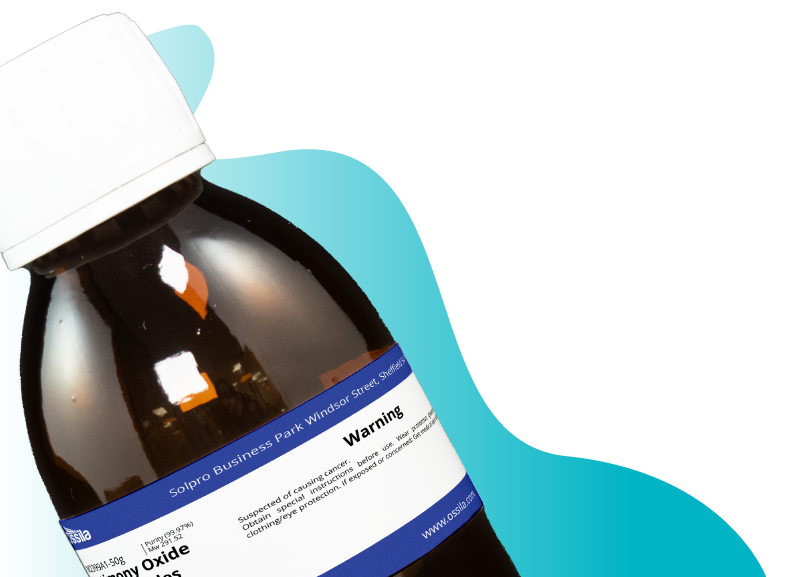Tungsten Ditelluride (WTe2) Powder and Crystal
CAS Number 12067-76-4
2D Materials, Low Dimensional Materials, Materials, Transition Metal Chalcogenides (TMCs), Transition Metal Dichalcogenides (TMDs)Low price, high purity 2D tungsten ditelluride (WTe2) powder and crystals
Suitable for the creation of single or few-layer sheets via mechanical or liquid exfoliation
Technical Data | MSDS | Structure | Literature and Reviews | Related Products | Resources and Support
Tungsten ditelluride (WTe2), CAS number 12067-76-4, is a combination of the heaviest element in the common transition metal dihalcogenides (TMDCs) and a non-magnetically-thermoelectric semimetal (with reduced density of states at the Fermi level).
2D-layered tungsten ditelluride (WTe2) has recently received great research interest for its unique, non-saturating, and extremely large positive magnetoresistance (XMR) behaviour. With perfectly balanced electron-hole populations, this particular non-saturating XMR identified applications for WTe2 in information processing and storage devices.
Td-WTe2 was the first material proposed to be a type II Weyl semimetal, with a reduced density of states at the Fermi level coming from a small overlap between valence and conduction bands without a band gap. It has been reported that even single and dual-layer WTe2 films preserve the semimetallic nature, and both the films have equal hole and electron carrier concentrations. Additionally, WTe2 has been reported to exhibit pressure-induced superconductivity.
High Purity
>99.999% Tungsten Ditelluride Purity
Worldwide shipping
Quick and reliable shipping
Low Cost
Low Cost Tungsten Ditelluride
Powder & Crystal
Different Forms of Tungsten Ditelluride
We supply low price tungsten ditelluride in several different forms for a range of applications.

Tungsten Ditelluride Powder
Can be used for preparation of tungsten ditelluride sulfide nanoplates and ultrathin films
Available in quantities of 500 mg or 1 g
≥99.995% purity
From £220

Tungsten Ditelluride Crystals by Size
Can be used to produce single or few-layer tungsten ditelluride sheets via mechanical or liquid exfoliation
Small (≥10 mm2) or medium (≥25 mm2) crystals available*
≥99.999% purity
From £520
*Typical representative size, areas/dimensions may vary
Bulk single tungsten ditelluride crystal is most commonly used as sources from which single or few-layer sheets can be obtained via either mechanical or liquid exfoliation. Single tungsten ditelluride crystal or films produced from such crystals are suitable for study using atomic force microscopy or transmission electron microscopy.
Few-layer WTe2 nanosheets and nanoparticles can also obtained from tungsten ditelluride powder by liquid-exfoliation using sodium deoxycholate bile salt as surfactant. Topological Superconductivity can also be realised in potassium intercalated Td-WTe2.
Technical Data
| CAS Number | 12067-76-4 |
| Chemical Formula | WTe2 |
| Molecular Weight | 439.04 g/mol |
| Bandgap | ~0.7 eV [1] |
| Preparation | Synthetic - Chemical Vapour Transport (CVT) |
| Structure | Orthorhombic Td |
| Electronic Properties | 2D semiconductor, type II Weyl semimetal |
| Melting Point | 1020 °C (lit.) |
| Colour | Metallic black/Dark brown |
| Synonyms | Tungsten telluride, Tungsten(IV) telluride |
| Classification / Family | Transition metal dichalcogenides (TMDCs), 2D Semiconductor materials, Charge Density Wave (CDW), type II Weyl semimetal, Nano-electronics, Nano-photonics, Photovoltaic, Materials science |
Product Details
| Form | Purity |
|---|---|
| Powder | ≥99.995% |
| Crystal | ≥99.999% |
Pricing Table
| Product Code | Form | Size/Weight* | Price |
|---|---|---|---|
| M2112C1 | Powder | 500 mg | £220 |
| M2112C1 | Powder | 1 g | £350 |
| M2112A10 | Crystal | Small (≥10 mm2) | £520 ea. |
| M2112A25 | Crystal | Medium (≥25 mm2) | £850 ea. |
| M2112A00 | Crystal | Large** (≥100 mm2) | £2300 ea. |
*Typical representative size, areas/dimensions may vary
**Item with a lead time of 4 - 6 weeks, please contact for more information
Shipping is free for qualifying orders.
MSDS Documents
Structure of Tungsten Ditelluride
Distorted Td-WTe2 has proven to be the stable form over its semiconducting 2H-WTe2 structure. The distortion is induced by the tungsten chains that are arranged along the a axis of the orthorhombic unit cell. Electrical resistance along the a axis increases markedly when a magnetic field is applied perpendicularly to the dichalcogenide layers (along the c axis), resulting in the large magnetoresistance (LMR) effect.
In ambient conditions, WTe2 crystallises in a orthorhombic lattice - where tungsten atoms are coordinated by tellurium atoms in an octahedral environment. The unit cell contains two Te-W-Te layers (held together by van der Waals interaction), with one sheet rotating 180◦ with respect to the other. This stacking sequence is referred to as a 'distorted 1T (Td) structure.

Literature and Reviews
- Tungsten Ditelluride: a layered semimetal, C-H. Lee et al., Sci. Rep., 5, 10013 (2015); DOI: 10.1038/srep10013.
- Tungsten dichalcogenides (WS2, WSe2, and WTe2): materials chemistry and applications, A. Eftekhari, J. Mater. Chem. A, 5, 18299-18325 (2017); DOI: 10.1039/C7TA04268J.
- Phase stability of transition metal dichalcogenide by competing ligand field stabilization and charge density wave, K. Santosh et al, 2D Mater. 2 035019 (2015); doi:10.1088/2053-1583/2/3/035019.
Related Products
We stock a wide range of 2D materials available to purchase online. Please contact us if you cannot find what you are looking for.

 Tungsten ditelluride powder
Tungsten ditelluride powder

